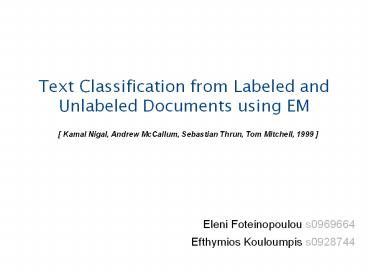Text Classification from Labeled and Unlabeled Documents using EM - PowerPoint PPT Presentation
Title:
Text Classification from Labeled and Unlabeled Documents using EM
Description:
Text Classification from Labeled and Unlabeled Documents using EM [ Kamal Nigal, Andrew McCallum, Sebastian Thrun, Tom Mitchell, 1999 ] Eleni Foteinopoulou s0969664 – PowerPoint PPT presentation
Number of Views:178
Avg rating:3.0/5.0
Title: Text Classification from Labeled and Unlabeled Documents using EM
1
Text Classification from Labeled and Unlabeled
Documents using EM
Kamal Nigal, Andrew McCallum, Sebastian Thrun,
Tom Mitchell, 1999
- Eleni Foteinopoulou s0969664
- Efthymios Kouloumpis s0928744
2
Overview
- Introduction
- Motivation
- Naïve Bayes Learning
- Combination of NB and EM
- EM Extensions
- Experiments
- Summary
3
Text Classification
Bag of Words
4
Need for an intermediate approach
- Unsupervised and Supervised learning
- Unsupervised learning
- collection of documents without any labels
- easy to collect, free, inexpensive, large pool
- Supervised learning
- each object tagged with a class
- laborious job, time-consuming process
- Semi-supervised learning
- Real life applications
5
Challenges
- How to reduce the number of labeled examples?
- Can unlabeled examples increase the
classification accuracy? - Any ideas...?
- Semi-Supervised Learning
6
Motivation
- Document collection D
- A subset (with ) has known
labels - Goal to label the rest of the collection.
- Approach
- Train a supervised learner using , the
labeled subset. ? NB - Apply the trained learner on the remaining
documents. ? EM - Idea
- Harness information from unlabeled subset.
7
The Generative Model
- Probabilistic generative model
- Every document Probability distribution
- Assumptions
- Mixture model
- One to one correspondence between
mixture components and classes - Document length distribution
8
Naïve Bayes Learning
- Assign each document to a particular mixture
component. - The parameters of an individual mixture
component form a multinomial distribution over
words - Estimate model parameters ? maximum a posteriori
estimation
9
Naïve Bayes Learning
- Maximum a posteriori estimate of the model
parameters given a small set of labeled data ?
high variance - How to improve parameter estimates?
- Incorporate unlabeled documents
10
EM Algorithm
- Iterative algorithm for parameter estimation
(maximum a posteriori) - Incomplete data ? missing labels
- Estimate parameters ? from labeled subset
- Iterate
- E step calculate probabilistic labels for the
unlabeled documents using current parameter
estimate ?. - M step maximize the complete likelihood ? new
maximum a posteriori estimate using current
estimates of - Continue till convergence ? ? local max.
11
EM Issues
- Generative model vs. real-world text data
- Mixture model - One to one correspondence
between mixture components and classes - Same parameter model as used in
- classification ? violation
- Word conditional independence
- NB assumption
- Extreme class probability estimates
12
EM Extensions
- Real world data?
- Weighting factor
- Multiple mixture components
13
EM Reducing belief in unlabeled data
- Problems due to unlabeled data
- Noise in term distribution of documents in
- Mistakes in E-step
- Solution
- attenuate the contribution from documents in
- Add a damping factor ae0,1, in E Step for
contribution from
14
EM Modeling labels using many mixture components
- Previous extension ? reduces effect of mixture
model assumption - Goal Relax assumption of one to one
correspondence between mixture components and
class labels. - Introduce many to one mapping ? missing values D
- E.g. For two class case football vs. not
football - Documents not about football are actually about
a variety of other things
15
EM Modeling labels using many mixture components
- Lower accuracy with one mixture component per
label ? not naturally modeled - Higher accuracy with more mixture components per
label ? word dependencies - Over fitting and poor performance with too large
mixture components
16
Experiments
- Unlabeled Data EM (Newsgroup articles)
17
Experiments
- Unlabeled Data EM (web pages)
18
Experiments
- Varying the weights on Unlabeled Data
19
Summary - Conclusions
- Labels are expensive
- Unlabeled data supplement scarce labeled data
- reduce classification error up to 30
- Data inconsistency with generative model
assumptions - Extensions of EM
- Weighted unlabeled data prevents decrease of
accuracy - Many to one mixture components.
- Future Work
- Incremental learning algorithm using unlabeled
data of test phase































